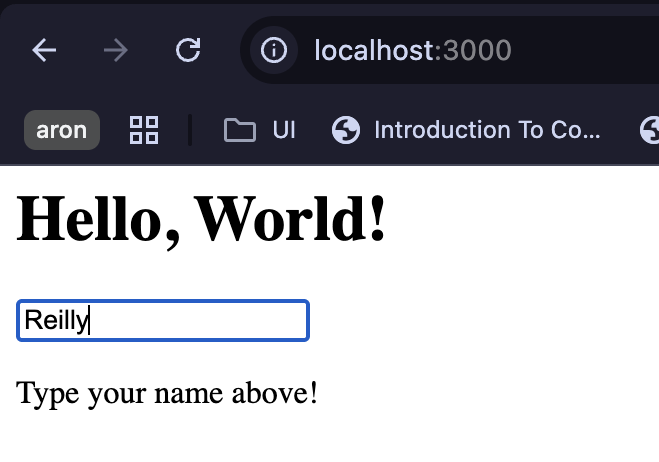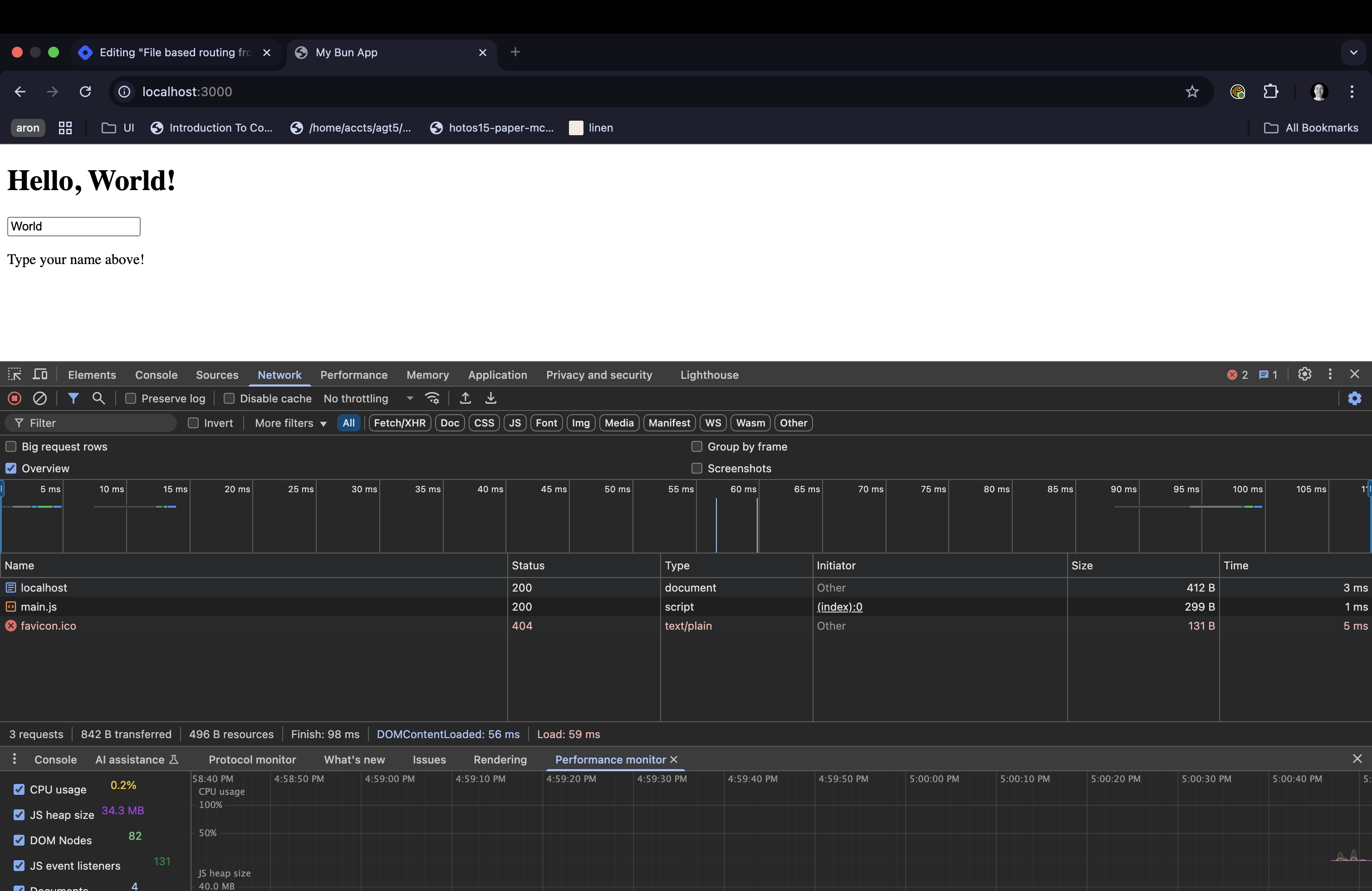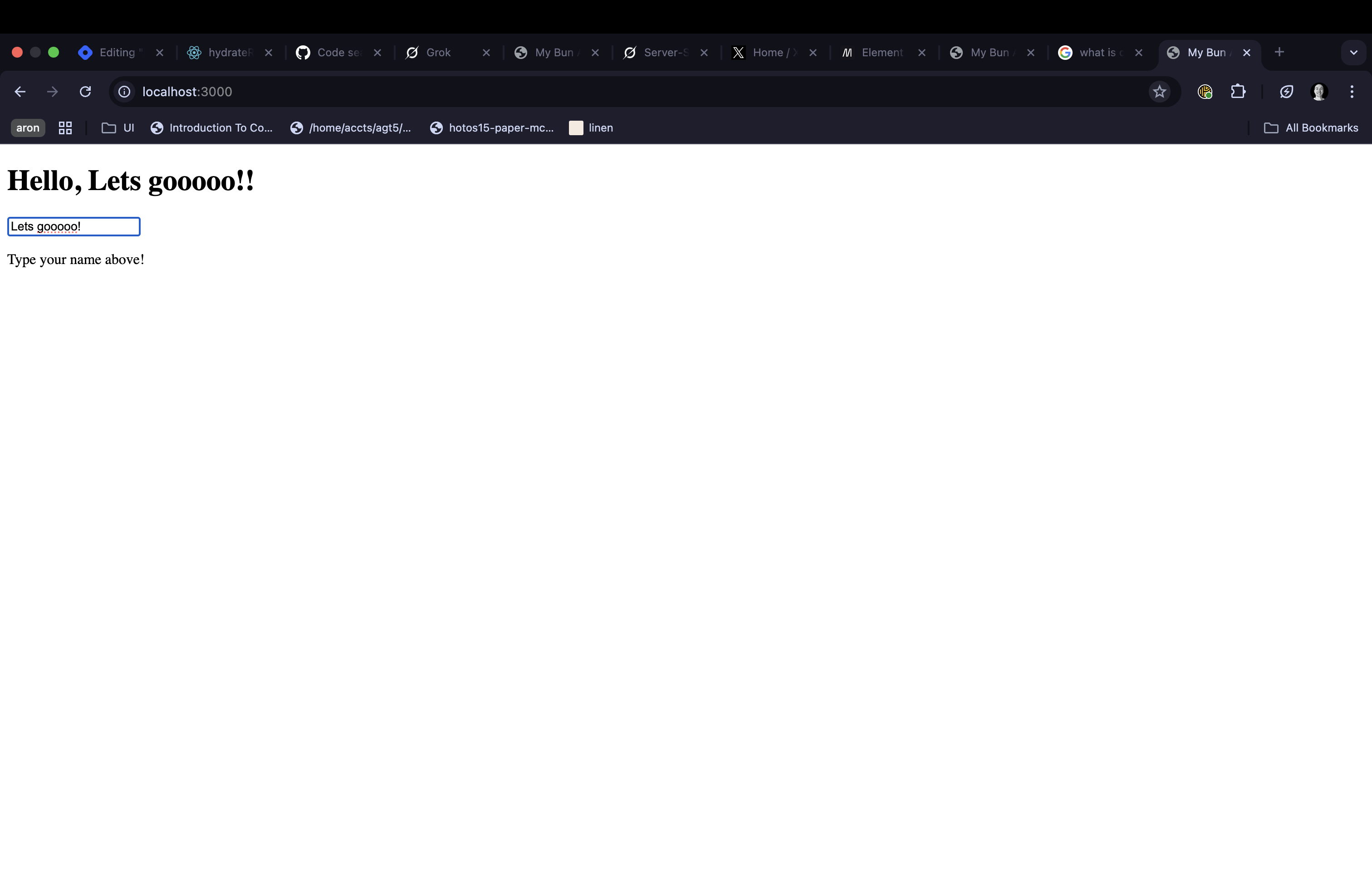Diving into SSR with bun & react 19
 Reilly O'Donnell
Reilly O'Donnell
Intro
Hello it’s me from the future! I originally was going to go over file based routing but pivoted to going over important SSR concepts with React / how Bun makes it easy. It’s full of struggles with hydration (mismatches), React entry points, and how Bun handles jsx/ts.
At the end you’ll have a better grasp on how React handles rendering on the server via a stream, hydrating on the client, and you’ll have a working project to show!
Hope you learn something new!
Start
Begin with `bun init` to start a new project. Bun comes with TS & JSX baked in (literally has a transpiler step in the code that converts ts / JSX to js - [lexer is here if interested](https://github.com/oven-sh/bun/blob/main/src/js_lexer.zig) which means we don’t have to worry about that.
Ok the first step with ANY problem is that we need to understand the problem and have a starting mental model of HOW the problem works.
When you use an app that uses routing in general when you navigate to “/some/route” the files (i.e. html, css, js) mapped to those routes are sent to the browser. But something has to send it?
Have the intuition for what can send it?
-
-
an http server!
HTTP server
Bun has it’s own syntax for an http server [here](https://bun.sh/docs/api/http)
With this:
Bun.serve({
port: 3000,
routes: {
'/': () => new Response('Hello World'),
'/bye': () => new Response('Goodbye!'),
},
});
console.log('Server running on http://localhost:3000');
run bun run index.ts
Got an error?
That just means you need the latest version of bun w bun upgrade
If you see the console log you’re golden!
Let’s visit localhost:3000/ you should see “hello world” in the browser!
If you check the Network tab it’ll also show a content type of text/plain;charset=utf-8
Add React
bun i react && bun i -D @types/react
Now I sorta want to just return some jsx for each separate route. Like:
import React from 'react';
Bun.serve({
port: 3000,
routes: {
'/': () => new Response(Hello),
'/bye': () => new Response(Bye),
},
});
console.log('Server running on http://localhost:3000');
function Hello() {
const [name, _] = React.useState('World');
return <h1>Hello, {name}!</h1>;
}
function Bye() {
return <h1>Goodbye!</h1>;
}
note since we’re using JSX we HAVE to update the file to end in .tsx/.jsx
But there’s a fundamental flaw in this idea.
Anything that crosses network boundaries has to be serialized - fancy word for a string.
So how do we turn Hello and Bye to strings?
if we invoke via <Hello /> That's not getting the underlying string bc that goes through React and instantiates a fiber and all that. What we're really wanting / needing is the underlying HTML that represents this code.
React offers 2 api’s to get the underlying HTML and it’s the basis of all SSR apps. renderToString which transforms your react tree into html and renderToReadableStream which does the same but streams it to better scale / gets you a faster Time To First Byte TTFB.
We’ll do the stream approach but both work :D
Make sure you’ve got react-dom which is where the above api comes from
bun i react-dom
Streams in bun
Streams are as simple as passing it to the Response as the first argument:
import React from 'react';
import { renderToReadableStream } from 'react-dom/server';
Bun.serve({
port: 3000,
routes: {
'/': async () =>
new Response(await renderToReadableStream(<Hello />)),
'/bye': async () =>
new Response(await renderToReadableStream(<Bye />)),
},
});
console.log('Server running on http://localhost:3000');
function Hello() {
const [name, _] = React.useState('World');
return <h1>Hello, {name}!</h1>;
}
function Bye() {
return <h1>Goodbye!</h1>;
}
When you run the server and visit the above routes it’s working!
Sprinkle some 🪄 interactivity
Let’s make the Hello component more interactive by utilizing the dispatch and returning some stuff to make it interactive to the user:
function Hello() {
const [name, setName] = React.useState('World');
return (
<div>
<h1>Hello, {name}!</h1>
<input
type="text"
value={name}
onChange={(e) => setName(e.target.value)}
/>
<p>Type your name above!</p>
</div>
)
}
Sweet! Now let’s restart the server and run it and visit localhost:3000/
tired of restarting?
bun run --hot index.tsx

It’s not updating??
Let’s look at the payload sent from the server:
<div>
<h1>Hello,
<!-- -->
World
<!-- -->
!</h1>
<input type="text" value="World"/>
<p>Type your name above!</p>
</div>
So when we’re typing it’s updating the value but that World is hardcoded. We need the corresponding JS that updates the string in the html. This is called hydration
We’ll need to update the server to send the needed JS so that when the user DOES type something the JS runs, updating the state, and updating what we see visually.
But before that we’ll need to explain some really important React concepts bc the above code needs to change a bit:
Quick aside: Important React ideas before we go further
React needs an entry point in the HTML. It’s a major part of HOW react works under the hood - specifically it’s diffing algorithm.
Which means we’ll need to give react an entry point - canonically this is some html id we target.
Then we need to “attach” react to that targeted entry point via a hydrateRoot call
to implement we’ll need the html created from renderToReadableStream then a js file containing a hydrateRoot call to attach react.
Back to the code:
Providing an entry point for React
From the docs for one of the arguments to renderToReadableStream
- optional
bootstrapScripts: An array of string URLs for the<script>tags to emit on the page. Use this to include the<script>that callshydrateRoot. Omit it if you don’t want to run React on the client at all.
So we’ll need to prep a js file and attach it as the arg.
The gist of what the script needs to do is -
target some html node
pass that node into
hydrateRootas well as the react node we want to render (Hello/ Bye) - we’ll need to import
[here’s how it’s done in the docs] (https://react.dev/reference/react-dom/client/hydrateRoot#:~:text=import%20%7B%20hydrateRoot,reactNode)%3B)
import { hydrateRoot } from 'react-dom/client';
import { Hello } from '.'
const domNode = document.getElementById('root');
if(domNode)hydrateRoot(domNode, <Hello />);
Then we’ll need to include this file (main.js) in the arguments passed like so:
new Response(
await renderToReadableStream(
`
<html>
<head>
<title>My Bun App</title>
</head>
<body>
<div id="root">
${(<Hello />)}
</div>
</body>
</html>`,
{
bootstrapScripts: ['/main.js'],
}
)
),
This doesn’t work though!
To understand let’s go look at what renderToReadableStream [here](https://react.dev/reference/react-dom/server/renderToReadableStream#parameters)
The first parameter is:
A React node you want to render to HTML. For example, a JSX element like
<App />. It is expected to represent the entire document, so theAppcomponent should render the<html>tag.
So we’ll need to update and have it render html instead of a string.
Then for the second object it says:
- optional
bootstrapScripts: An array of string URLs for the<script>tags to emit on the page. Use this to include the<script>that callshydrateRoot. Omit it if you don’t want to run React on the client at all.
Further down it says:
React will inject the doctype and your bootstrap <script> tags into the resulting HTML stream:
Let’s make the first change and take a look at the response from the server.
Here’s the change:
import React from 'react';
import { renderToReadableStream } from 'react-dom/server';
Bun.serve({
port: 3000,
routes: {
'/': async () => {
return new Response(
await renderToReadableStream(<Hello />, {
bootstrapScripts: ['/main.js'],
})
);
},
'/bye': async () => new Response(await renderToReadableStream(<Bye />), {}),
},
});
console.log('Server running on http://localhost:3000');
export function Hello() {
const [name, setName] = React.useState('World');
return (
<html>
<head>
<title>My Bun App</title>
</head>
<body>
<div id="root">
<h1>Hello, {name}!</h1>
<input
type="text"
value={name}
onChange={(e) => setName(e.target.value)}
/>
<p>Type your name above!</p>
</div>
</body>
</html>
);
}
export function Bye() {
return <h1>Goodbye!</h1>;
}
We get a 404 for main.js!
The request that comes in for /main.js looks something like localhost:3000/main.js since there’s not a route covered / we’re not handling a fallback it automatically returns a 404.
Also remember earlier when we talked about renderToString (which is blocking in that the response isn’t send until the entire react tree is rendered and turned into a string?) and it’s alt the renderToReadableStream? There’s the two same ideas for reading a file and returning it’s contents for http servers. Thankfully Bun makes it REALLY easy to stream a file. [docs here](https://bun.sh/docs/api/http#streaming-files)
Their example is
Bun.serve({
fetch(req) {
return new Response(Bun.file("./hello.txt"));
},
});
That’s dead simple. Under the hood Bun is auto streaming it so no matter how big the file is it will always respond quickly!
Let’s put these 2 ideas - handling the request for /main.js and serving the contents of a file as a stream together:
import React from 'react';
import { renderToReadableStream } from 'react-dom/server';
Bun.serve({
port: 3000,
routes: {
'/': async () => {
return new Response(
await renderToReadableStream(<Hello />, {
bootstrapScripts: ['/main.js'],
})
);
},
'/bye': async () => new Response(await renderToReadableStream(<Bye />), {}),
},
fetch(req) {
if (req.url === 'main.js') new Response(Bun.file('main.js'));
return new Response('Not Found', { status: 404 });
},
});
console.log('Server running on http://localhost:3000');
export function Hello() {
const [name, setName] = React.useState('World');
return (
<html>
<head>
<title>My Bun App</title>
</head>
<body>
<div id="root">
<h1>Hello, {name}!</h1>
<input
type="text"
value={name}
onChange={(e) => setName(e.target.value)}
/>
<p>Type your name above!</p>
</div>
</body>
</html>
);
}
export function Bye() {
return <h1>Goodbye!</h1>;
}
I also added a fallback so now it manually returns a 404. Note that I’ve used the fetch. This is straight from the docs. Read more here
Notice my mistake? I’m checking if the url === 'main.js' which it never will. The req.url will be something like http://localhost:3000/main.js
It’s the pathname we want!
async fetch(req) {
const path = new URL(req.url).pathname;
if (path === '/main.js') return new Response(Bun.file('main.js'));
return new Response('Not Found', { status: 404 });
}
Rerun the server (if applicable) and check the network tab

no 404! But when we type it doesn’t update. In the logs:
Uncaught SyntaxError: Cannot use import statement outside a module (at main.js:1:1)
Ah ok. Well the browser DOES understand ESM. The problem can be found when we inspect the html returned in the network tab:
<!DOCTYPE html>
<html>
<head>
<link rel="preload" as="script" fetchPriority="low" href="/main.js"/>
<title>My Bun App</title>
</head>
<body>
<div id="root">
<h1>Hello,
<!-- -->
World
<!-- -->
!</h1>
<input type="text" value="World"/>
<p>Type your name above!</p>
</div>
<script src="/main.js" async=""></script>
</body>
</html>
In the docs you can use:
optional bootstrapModules: Like bootstrapScripts, but emits <script type="module"> instead.
Perfect! Let’s use that instead of the bootstrapScripts
Ok! Here’s the updated code:
import React from 'react';
import { renderToReadableStream } from 'react-dom/server';
Bun.serve({
port: 3000,
routes: {
'/': async () => {
return new Response(
await renderToReadableStream(<Hello />, {
bootstrapModules: ['/main.js'],
})
);
},
'/bye': async () => new Response(await renderToReadableStream(<Bye />), {}),
},
async fetch(req) {
const path = new URL(req.url).pathname;
if (path === '/main.js') return new Response(Bun.file('main.js'));
return new Response('Not Found', { status: 404 });
},
});
console.log('Server running on http://localhost:3000');
export function Hello() {
const [name, setName] = React.useState('World');
return (
<html>
<head>
<title>My Bun App</title>
</head>
<body>
<div id="root">
<h1>Hello, {name}!</h1>
<input
type="text"
value={name}
onChange={(e) => setName(e.target.value)}
/>
<p>Type your name above!</p>
</div>
</body>
</html>
);
}
export function Bye() {
return <h1>Goodbye!</h1>;
}
Ok another error! We’ve almost got this!
Uncaught SyntaxError: Unexpected token '<' (at main.js:6:24)
Ah we’re using JSX in the main.js file (not really js) :/ so we’ll need to transpile it with Bun. We can do that with Bun.build we’ve got a couple options - we can do it for every request or do it once when the server starts/restarts… The second is a better idea.
Also I’m going to update main.js to be main.tsx since it’s going to be transpiled/compiled/whatever you wanna call it.
We want to compile that file when the server starts and output it somewhere. Then when requests come in for that file we can just serve the js file.
Ok. All in you get this:
import React from 'react';
import { renderToReadableStream } from 'react-dom/server';
Bun.build({
entrypoints: ['./main.tsx'],
outdir: 'dist',
});
Bun.serve({
port: 3000,
routes: {
'/': async () => {
return new Response(
await renderToReadableStream(<Hello />, {
bootstrapModules: ['/dist/main.js'],
})
);
},
'/bye': async () => new Response(await renderToReadableStream(<Bye />), {}),
},
async fetch(req) {
const path = new URL(req.url).pathname;
if (path === '/main.js') return new Response(Bun.file('main.js'));
return new Response('Not Found', { status: 404 });
},
});
console.log('Server running on http://localhost:3000');
export function Hello() {
const [name, setName] = React.useState('World');
return (
<html>
<head>
<title>My Bun App</title>
</head>
<body>
<div id="root">
<h1>Hello, {name}!</h1>
<input
type="text"
value={name}
onChange={(e) => setName(e.target.value)}
/>
<p>Type your name above!</p>
</div>
</body>
</html>
);
}
export function Bye() {
return <h1>Goodbye!</h1>;
}
Another error! Uncaught ReferenceError: Bun is not defined because we’re sending main.js to the client to be executed to enable hydration, our import for hello, import { Hello } from '.', is sending all of the code in that file!
To resolve this, move the components into a separate file. Which means we need to:
change the import in main.tsx
in
index.tsximport the components in the location you chose,app.tsxfor me.
Ok. After this I’ve run into ANOTHER error. Hydration mismatch causing the cpu to spike to 100%.
hydrateRoot / wtf even is hydration
In trying to debug this cpu issue I found some gaps in my understanding.
To start the definition is really confusing imo:
hydrateRootlets you display React components inside a browser DOM node whose HTML content was previously generated byreact-dom/server
Further down in the docs on hydrateRoot there’s a bit more helpful info:
Call hydrateRoot to “attach” React to existing HTML that was already rendered by React in a server environment… hydrateRoot() expects the rendered content to be identical with the server-rendered content.
that explains everything we need to know: when you render html from react, the rendered content has to be identical to the server-content and since hydrate root expects an entry - it has to be THE entry, i.e. the html tag aka document.
Let’s put it all together now!
Ok, be sure to move the components to their own files. Then update main.tsx
import { hydrateRoot } from 'react-dom/client';
import { Hello } from './app';
hydrateRoot(document, <Hello />);
index.tsx
import { renderToReadableStream } from 'react-dom/server';
import { Bye, Hello } from './app';
await Bun.build({
entrypoints: ['./main.tsx'],
outdir: 'dist',
});
Bun.serve({
port: 3000,
routes: {
'/': async () => {
try {
const stream = await renderToReadableStream(<Hello />, {
bootstrapModules: ['main.js'],
});
return new Response(stream, {
headers: {
'Content-Type': 'text/html',
},
status: 200,
});
} catch (error) {
console.error('Error rendering Hello component:', error);
return new Response('Internal Server Error', { status: 500 });
}
},
// '/bye': async () => new Response(await renderToReadableStream(<Bye />), {}),
},
async fetch(req) {
const path = new URL(req.url).pathname;
if (path === '/main.js')
return new Response(Bun.file('dist/main.js'), {
headers: {
'Content-Type': 'application/javascript',
},
});
return new Response('Not Found', { status: 404 });
},
});
console.log('Server running on http://localhost:3000');
app.tsx
import React from 'react';
export function Hello() {
const [name, setName] = React.useState('World');
return (
<html>
<head>
<title>My Bun App</title>
</head>
<body>
<div id="root">
<h1>Hello, {name}!</h1>
<input
type="text"
value={name}
onChange={(e) => setName(e.target.value)}
/>
<p>Type your name above!</p>
</div>
</body>
</html>
);
}
export function Bye() {
return <h1>Goodbye!</h1>;
}
And what it looks like visually:

Subscribe to my newsletter
Read articles from Reilly O'Donnell directly inside your inbox. Subscribe to the newsletter, and don't miss out.
Written by

Reilly O'Donnell
Reilly O'Donnell
If you've got any questions feel free to DM on Twitter @reillyjodonnell